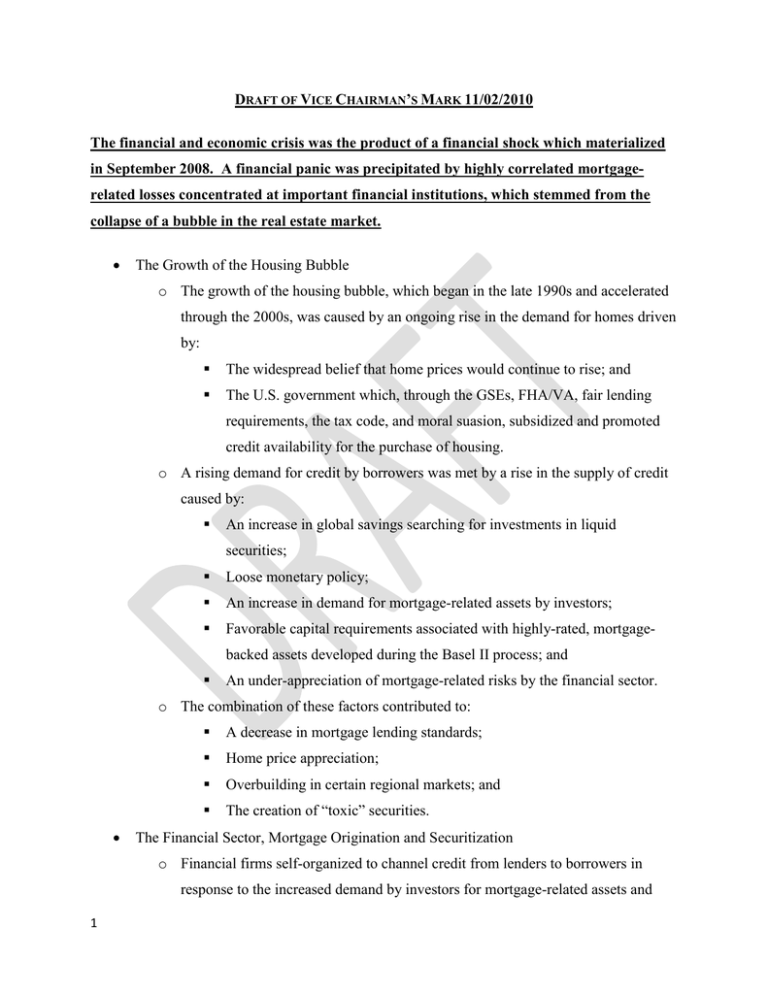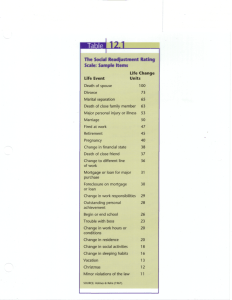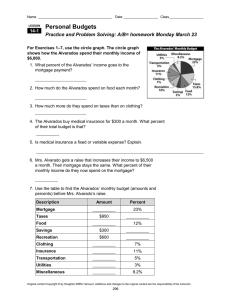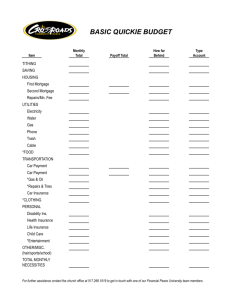’ D V C
advertisement

DRAFT OF VICE CHAIRMAN’S MARK 11/02/2010 The financial and economic crisis was the product of a financial shock which materialized in September 2008. A financial panic was precipitated by highly correlated mortgagerelated losses concentrated at important financial institutions, which stemmed from the collapse of a bubble in the real estate market. The Growth of the Housing Bubble o The growth of the housing bubble, which began in the late 1990s and accelerated through the 2000s, was caused by an ongoing rise in the demand for homes driven by: The widespread belief that home prices would continue to rise; and The U.S. government which, through the GSEs, FHA/VA, fair lending requirements, the tax code, and moral suasion, subsidized and promoted credit availability for the purchase of housing. o A rising demand for credit by borrowers was met by a rise in the supply of credit caused by: An increase in global savings searching for investments in liquid securities; Loose monetary policy; An increase in demand for mortgage-related assets by investors; Favorable capital requirements associated with highly-rated, mortgagebacked assets developed during the Basel II process; and An under-appreciation of mortgage-related risks by the financial sector. o The combination of these factors contributed to: A decrease in mortgage lending standards; Home price appreciation; Overbuilding in certain regional markets; and The creation of “toxic” securities. The Financial Sector, Mortgage Origination and Securitization o Financial firms self-organized to channel credit from lenders to borrowers in response to the increased demand by investors for mortgage-related assets and 1 increased demand for credit by mortgage borrowers. This was accomplished in part through an expansion of the “originate-to-distribute” model of housing finance, in which loans were sold to the secondary market and securitized, rather than being held to maturity by the originating institution. o Mortgage securitization required the involvement of a number of types of financial actors, products and entities. In many cases the same firm played a number of roles in this process (including acting as the end-investor, when the firm did not believe there was a sufficiently high price to sell a structured asset into the market). A selection of these actors, products and entities are highlighted below: Mortgage originators originated and sold whole loans to mortgage securitizers; Mortgage securitizers created securities from loan pools to sell to endinvestors (which included the pension funds, insurance companies, domestic and foreign banks, GSEs, hedge funds, and CDO managers, among others); To create securities to accommodate the risk level demanded by endinvestors, mortgage securitizers and CDO structurers purchased insurance in the form of credit guarantees or derivatives; To finance the securitization pipeline, mortgage originators, mortgage securitizers, and CDO structurers established lines of credit with large depository institutions and investment banks, issued short-term debt, and created asset-backed commercial paper conduits; Securitizing firms mitigated the liquidity and credit risk associated with securitization (and the associated capital requirements) by placing these exposures in self-financing off-balance sheet structures, and then purchasing liquidity protection on those off-balance sheet structures from large depository institutions and obtaining credit protection from derivatives dealers. These off-balance sheet entities became a source of risk during the crisis. 2 In response to investor demand for credit ratings to determine risk-based capital requirements; to satisfy statutory investment limitations; and as a proxy for risk management by end-investors; credit rating agencies were paid to rate the credit risk of these securitized products. o Financial firms involved in mortgage securitization were regulated on the state and/or federal level on the basis of consumer protection, investor protection, and/or safety-and-soundness. o In retrospect, it is clear that few, if any, of the market participants involved in mortgage securitization or their regulators appreciated the risks inherent in the mortgage-related assets whose creation they were facilitating. Moreover, the lack of transparency and poor risk management resulted in a concentration of mortgage risk on balance sheets of large financial institutions. As a result, across the financial system not enough capital was held against the risks associated with the mortgage business. The Collapse of the Bubble, Mortgage-related Losses and the Failure of Financial Firms o The leveling of home price values nationally in 2006 and their subsequent decline in 2007 combined with the weak underwriting of mortgages in the housing market caused default rates and loss severity (i.e. losses realized in a default) to mount to unexpectedly high levels, placing strain on institutions holding mortgage-related credit risk. o Firms and other entities with concentrated exposures to the mortgage market (e.g. mortgage originators and hedge funds) were run by creditors (primarily in shortterm debt markets, such as commercial paper and repo) and failed. Other financial firms began to experience mark-to-market losses (or collateral calls) on their mortgage-related assets (or mortgage-related derivatives). In addition, many firms which had off-balance sheet exposures to the mortgage market began to consolidate those exposures in response to reputational concerns, further increasing their on-balance sheet mortgage-related exposure. o Bear Stearns, in March 2008, was the first major U.S. financial firm to collapse. Bear Stearns experienced acute liquidity strains as major counterparties refused to 3 lend even on an overnight, secured basis, leading to a government-assisted merger with JPMorgan Chase. o As a result of the Bear Stearns rescue, creditors of other large financial institutions assumed they would be backstopped by the U.S. government. Additionally, financial firm managers and potential merger partners came to anticipate an increased likelihood of government assistance in future mergers. o Following the collapse of Bear Stearns, the government, principally through the Federal Reserve, engaged in rapid monetary easing and established a number of facilities to provide secured loans to financial institutions and backstop funding markets. o Another important series of government actions taken to promote liquid markets was the extension of liquidity support to the GSEs on July 13 and the decision by the Federal Housing Finance Agency to place Fannie Mae and Freddie Mac into conservatorship on September 7. These actions supported a collapsing secondary market for mortgages and the made explicit the guarantee on the GSEs’ liabilities. o In early September, counterparties of Lehman Brothers, concerned with Lehman’s commercial real estate portfolio, refused to lend to Lehman. After exhausting potential merger partners, and with the government unwilling to lend to the failing firm on a secured basis, Lehman Brothers entered into bankruptcy on September 15. Lehman’s bankruptcy surprised those debtholders that expected they would be made whole by the government – and shocking financial market participants more generally. o On September 15, it was announced that Merrill Lynch would be acquired by Bank of America. On September 16, AIG was extended an emergency loan by the Federal Reserve and the Reserve Primary Fund “broke the buck.” The Panic o Given that financial firms are, by their nature, highly leveraged with mismatched maturities between their assets and liabilities, they are susceptible to liquidity runs. These runs can quickly spread throughout the financial system, as counterparties, fearful that their investments will be tied up in a failing firm or that they may need excess liquidity themselves to stem a creditor run, move their 4 investments to safer asset classes. The conservatorship of the GSEs, the bankruptcy of Lehman Brothers, the failure of AIG and the merger of Bank of America and Merrill Lynch and the Reserve Primary Fund “breaking the buck” set off a financial panic: Borrowing in debt markets of all types became only possible at a prohibitive risk premium; Firms and money funds reliant on short-term debt funding were run by counterparties in the commercial paper and repo markets; Washington Mutual and Wachovia, insured depository institutions with large perceived exposures to mortgage-related assets, experienced depositor runs. o Once in the panic, the only available policy response was to provide liquidity to build investor confidence that banks would be able to honor their short-term obligations. The government intervened in a number of ways, including: Providing emergency credit to and taking on the mortgage-related exposures of AIG; Arranging mergers for Washington Mutual and Wachovia; Creating new Federal Reserve liquidity facilities; Improving the liquidity position of depository institutions by increasing the level of FDIC depository insurance and guaranteeing newly issued senior debt. o The government also intervened to help rebuild the capital position of financial firms as a part of the “Troubled Asset Relief Program”. The Severe Recession o The economy entered the financial crisis in a mild recession. Housing value and construction declines had translated into drags on the household and investment sectors. Record high oil prices also hurt household ability to spend. o Following the panic, certain debt markets have contracted substantially and others continue to operate with elevated risk premia relative to prior to the crisis. 5 o Lack of credit (both due to ongoing instability in credit markets and the sudden reversal of lending standards that were too loose prior to the crisis) and a global reduction in trade flows, created a sharp and deep recession. 6



